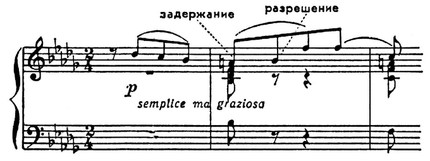
Detention |
ital. ritardo; German Vorhalt, French and English. suspension
A non-chord sound on a downbeat that delays the entry of an adjacent chord note. There are two types of Z.: prepared (the sound of Z. remains from the previous chord in the same voice or is included in the previous chord in another voice) and unprepared (the sound of Z. is absent in the previous chord; also called apodjatura). Cooked Z. contains three moments: preparation, Z. and permission, unprepared – two: Z. and permission.

Palestrina. Motet.

P. I. Tchaikovsky. 4th symphony, movement II.
The preparation of the Z. can also be carried out with a non-chord sound (as if by way of the Z.). Unprepared Z. often has the form of a passing or auxiliary (as in the 2nd note) sound that fell on the heavy beat of the measure. The Z. sound is resolved by moving a major or minor second down, a minor and (rarely) major second up. Resolution can be delayed by introducing other sounds between it and Z. – chord or non-chord.
Often there are so-called. double (in two voices) and triple (in three voices) Z. Double prepared Z. can be formed in those cases when, when changing harmony, two voices go to a major or minor second – in one direction (parallel thirds or fourths) or in opposite directions directions. With a triple prepared Z., two voices move in one direction, and the third in the opposite direction, or all three voices go in the same direction (parallel sixth chords or quarter-sextakhords). Unprepared double and triple grains are not bound by these formation conditions. The bass in double and triple delays is usually not involved and remains in place, which contributes to a clear perception of the change in harmony. Double and triple z. may not be resolved simultaneously, but alternately in decomp. votes; the resolution of the delayed sound in each of the voices is subject to the same rules as the resolution of a single Z. Due to its metric. position on the strong share, Z., especially unprepared, has a great influence on the harmonic. vertical; with the help of Z., consonances that are not included in the classical can be formed. chords (e.g. fourths and fifths). Z. (as a rule, prepared, including double and triple) were widely used in the era of polyphony of strict writing. After the approval of homophony Z. in the leading upper voice constituted an important feature of the so-called. gallant style (18th century); such Z. were usually associated with “sighs”. L. Beethoven, striving for simplicity, rigor and masculinity of his music, deliberately limited the use of Z. Some researchers defined this feature of Beethoven’s melody by the term “absolute melody”.
The term Z. was apparently first used by G. Zarlino in his treatise Le istitutioni harmoniche, 1558, p. 197. Z. at that time was interpreted as a dissonant sound, requiring proper preparation and smooth descending resolution. At the turn of the 16-17 centuries. Z.’s preparation was no longer considered mandatory. From the 17th century Z. is increasingly considered as part of a chord, and the doctrine of Z. is included in the science of harmony (especially since the 18th century). “Unresolved” chords historically prepared one of the types of the new chord of the 20th century. (consonances with added, or side, tones).
References: Chevalier L., The history of the doctrine of harmony, trans. from French, Moscow, 1931; Sposobin I., Evseev S., Dubovsky I., Practical course of harmony, part II, M., 1935 (section 1); Guiliemus Monachus, De preceptis artis musice et practice compendiosus, libellus, in Coussemaker E. de, Scriptorum de musica medii-aevi…, t. 3, XXIII, Hlldesheim, 1963, p. 273-307; Zarlino G., Le institutioni harmonice. A facsimile of the 1558 Venice edition, NY, 1965, 3 parte, cap. 42, p. 195-99; Riemann H. Geschichte der Musiktheorie im IX-XIX. Jahrh., Lpz., 1898; Piston W., Harmony, NY, 1941; Chominski JM, Historia harmonii i kontrapunktu, t. 1-2, Kr., 1958-62.
Yu. H. Kholopov



